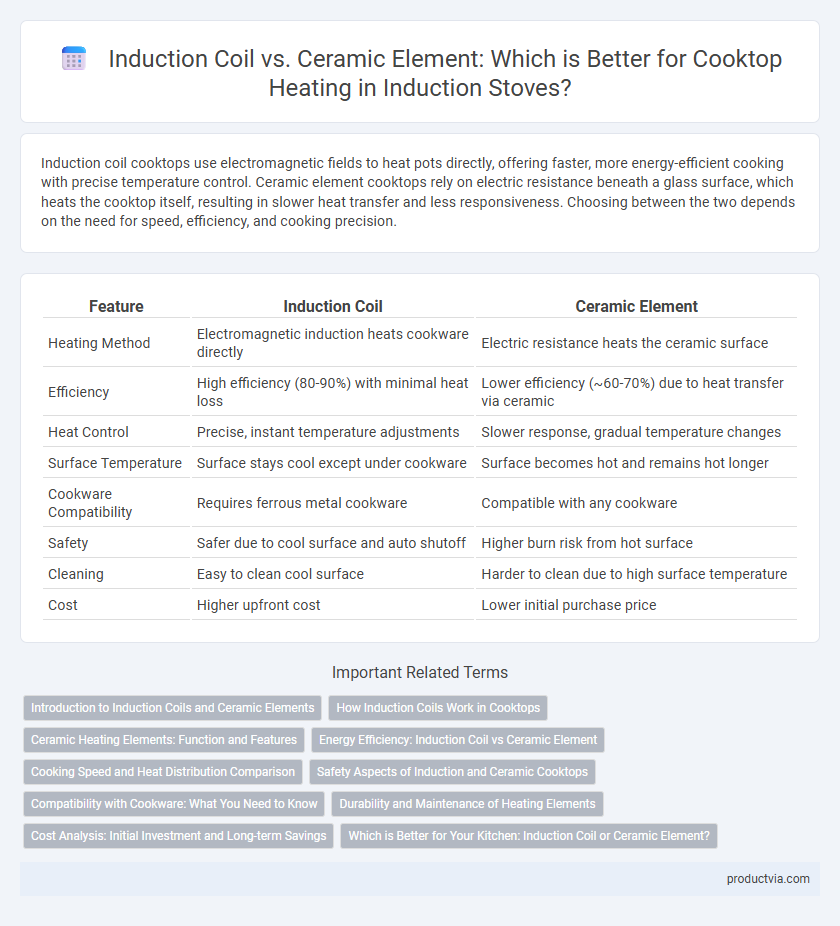Induction coil cooktops use electromagnetic fields to heat pots directly, offering faster, more energy-efficient cooking with precise temperature control. Ceramic element cooktops rely on electric resistance beneath a glass surface, which heats the cooktop itself, resulting in slower heat transfer and less responsiveness. Choosing between the two depends on the need for speed, efficiency, and cooking precision.
Table of Comparison
| Feature | Induction Coil | Ceramic Element |
|---|---|---|
| Heating Method | Electromagnetic induction heats cookware directly | Electric resistance heats the ceramic surface |
| Efficiency | High efficiency (80-90%) with minimal heat loss | Lower efficiency (~60-70%) due to heat transfer via ceramic |
| Heat Control | Precise, instant temperature adjustments | Slower response, gradual temperature changes |
| Surface Temperature | Surface stays cool except under cookware | Surface becomes hot and remains hot longer |
| Cookware Compatibility | Requires ferrous metal cookware | Compatible with any cookware |
| Safety | Safer due to cool surface and auto shutoff | Higher burn risk from hot surface |
| Cleaning | Easy to clean cool surface | Harder to clean due to high surface temperature |
| Cost | Higher upfront cost | Lower initial purchase price |
Introduction to Induction Coils and Ceramic Elements
Induction coils generate heat through electromagnetic fields that directly warm compatible cookware, providing rapid and precise temperature control for efficient cooking. Ceramic elements, on the other hand, use electric resistance to heat a glass-ceramic surface, which then transfers heat to the cookware, offering a smooth, easy-to-clean surface but slower response times. Understanding these fundamental differences highlights why induction coils are preferred for energy efficiency and faster cooking, while ceramic elements appeal for their simplicity and uniform heating.
How Induction Coils Work in Cooktops
Induction coils in cooktops generate a magnetic field that directly heats compatible cookware through electromagnetic induction, resulting in rapid and precise temperature control. Unlike ceramic elements that rely on radiant heat to transfer warmth to pots, induction coils produce heat within the pan itself, significantly improving energy efficiency. This technology reduces heat loss and provides safer, cooler cooktop surfaces compared to traditional ceramic elements.
Ceramic Heating Elements: Function and Features
Ceramic heating elements in cooktops operate by using electric resistance wires embedded beneath a smooth glass-ceramic surface, which radiate heat to warm cookware evenly. These elements provide rapid heat distribution and maintain consistent temperatures, making them suitable for various cooking tasks. Their flat surface allows for easy cleaning and a sleek appearance while offering reliable thermal efficiency without direct contact with the cookware.
Energy Efficiency: Induction Coil vs Ceramic Element
Induction coils offer superior energy efficiency by directly heating the cookware through electromagnetic induction, resulting in minimal heat loss and faster cooking times. Ceramic elements transfer heat indirectly through a glass-ceramic surface, causing more energy to dissipate into the surrounding environment. This direct energy transfer makes induction cooktops significantly more efficient compared to ceramic element cooktops.
Cooking Speed and Heat Distribution Comparison
Induction coils heat cookware directly through electromagnetic fields, resulting in faster cooking speeds and more precise temperature control compared to ceramic elements. Ceramic elements rely on radiant heat transfer, which causes slower heat-up times and less consistent heat distribution across the cooking surface. This direct heating mechanism of induction ensures efficient energy use and uniform cooking results, making it superior for tasks requiring rapid temperature changes.
Safety Aspects of Induction and Ceramic Cooktops
Induction cooktops utilize an induction coil that generates a magnetic field, directly heating only ferromagnetic cookware and leaving the cooktop surface relatively cool, significantly reducing burn risks and improving safety. Ceramic cooktops rely on radiant heating elements beneath a glass-ceramic surface, which remains hot for a longer period after cooking, posing a higher risk of burns. The precise and rapid temperature control of induction technology also minimizes overheating hazards compared to ceramic elements.
Compatibility with Cookware: What You Need to Know
Induction coils require compatible ferromagnetic cookware such as cast iron or stainless steel with a magnetic base, as they rely on electromagnetic fields to generate heat directly in the pan. Ceramic elements, on the other hand, can work with virtually any type of cookware, including aluminum, copper, glass, and non-magnetic stainless steel, since they heat the cooktop surface rather than the cookware itself. Understanding this key difference ensures optimal cooking performance and prevents compatibility issues when selecting between induction coil and ceramic element cooktops.
Durability and Maintenance of Heating Elements
Induction coils offer superior durability compared to ceramic elements, as they are less prone to cracking and wear due to the absence of direct heat exposure. Ceramic elements require careful handling to prevent surface damage and may need more frequent cleaning to maintain optimal performance. The maintenance of induction coils is minimal since the element itself remains cool, reducing the risk of buildup and extending the appliance's lifespan.
Cost Analysis: Initial Investment and Long-term Savings
Induction coils typically have a higher initial investment compared to ceramic elements due to advanced technology and materials used. However, induction cooktops offer significant long-term savings through faster heating times, greater energy efficiency of up to 90%, and reduced heat loss, which lowers electricity bills. Maintenance costs for induction systems are also generally lower since the smooth glass surface remains cooler, reducing wear and tear.
Which is Better for Your Kitchen: Induction Coil or Ceramic Element?
Induction coil cooktops use electromagnetic fields to directly heat cookware, offering rapid temperature control and superior energy efficiency compared to ceramic elements, which rely on electric resistance heating. Ceramic elements feature a smooth glass surface that heats slower and retains heat longer, but lack the precision and safety of induction technology. For modern kitchens prioritizing speed, energy savings, and precise cooking, induction coils present a better choice, while ceramic elements appeal to those valuing simplicity and lower upfront costs.
Induction coil vs Ceramic element for cooktop heating Infographic

 productvia.com
productvia.com